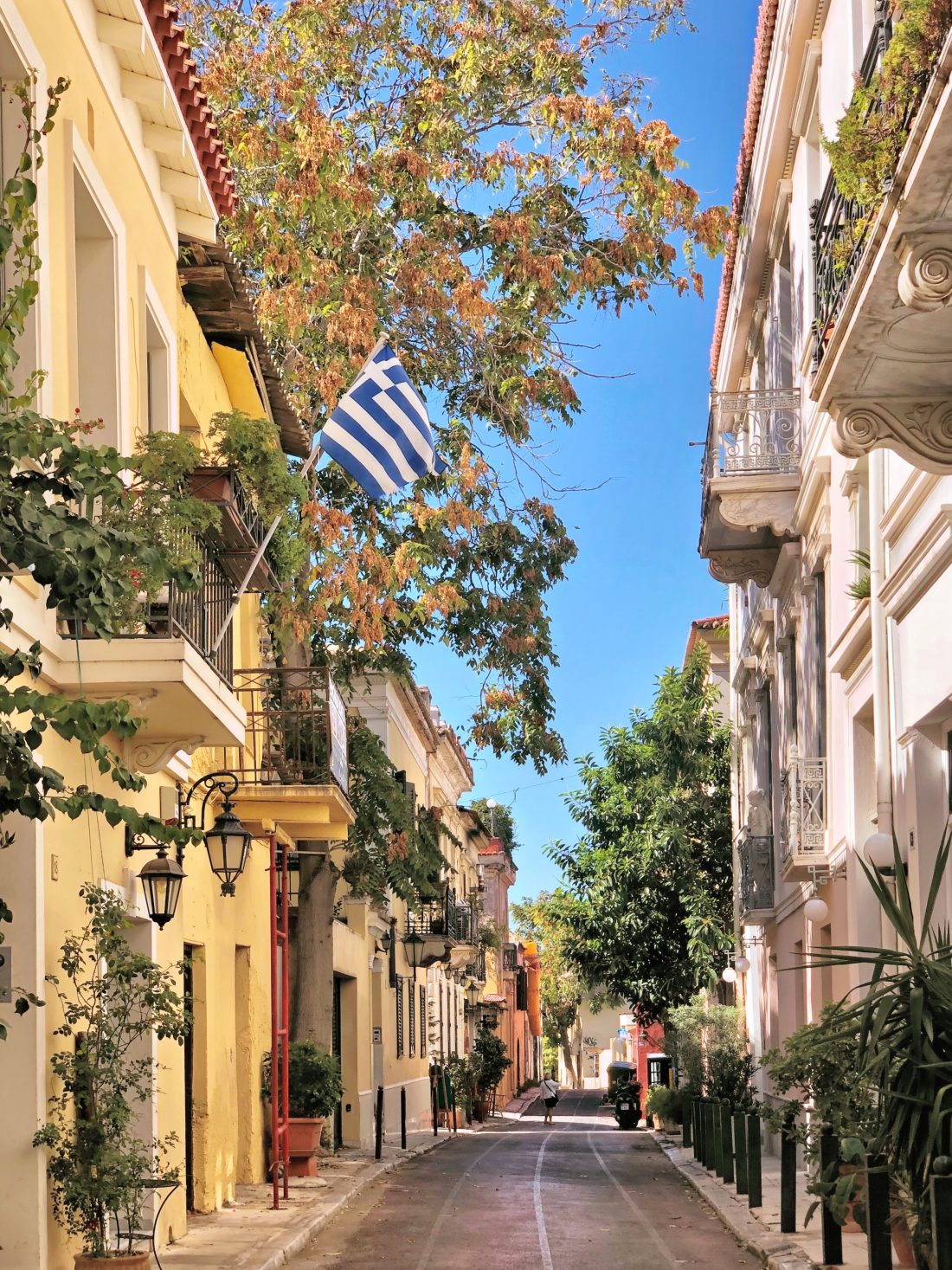Plaka District in Athens
An overview of Plaka
Situated at the foot of the Acropolis, Plaka is among the most ancient and charming neighborhoods in Athens. Known as the “quarter of the gods,” Plaka is renowned for its narrow, cobblestone streets, vibrant house facades, a variety of traditional shops and restaurants, and its warm, welcoming atmosphere. It’s a delightful labyrinth where one can enjoy getting lost while uncovering the city’s hidden gems.

A short history of Plaka
The roots of the Plaka district can be traced back to antiquity when Athens was a thriving city-state. Throughout the centuries, Plaka has borne witness to different eras of Greek history, from Roman and Byzantine rule to Greece’s independence in 1821.
Ancient times
In the era of ancient Greece, Plaka was a vital part of the Athenian city-state, housing residences, businesses, and places of worship. The neighborhood grew around the Agora, which served as the political, economic, and social hub of the city.
Roman domination
Following the Roman conquest in 146 BC, Athens relinquished its political roles but retained its status as a prominent cultural and intellectual center. Plaka continued to function as a residential and commercial area. Several Roman structures, including the Tower of the Winds and Hadrian’s Baths, were built in the district.
Byzantine era
During the Byzantine Empire (330-1453 AD), Athens went into gradual decline, and Plaka experienced considerable changes. Christianity emerged as the predominant religion, and a number of Byzantine churches, such as the Kapnikarea Church and the Church of Agios Nikolaos Rangavas, were erected in the neighborhood.
Ottoman rule
After Constantinople fell in 1453, Athens came under the control of the Ottoman Empire. Plaka persisted as a residential and commercial district, accommodating mosques and Turkish baths. The Ottoman influence had lasting effects on the neighborhood’s architecture and culture.
Greek independence and modern times
Greece gained its independence in 1821, making Athens the capital of the newly established Greek state. During the 19th century, numerous refugees and artisans from the islands, particularly Anafi, settled in the upper part of the district known as Anafiotika. They built traditional white houses with blue roofs characteristic of the Cyclades.
Over the course of the 20th century, Plaka transformed into a tourist hotspot with the opening of various shops, restaurants, and hotels.
Presently, Plaka is a favorite destination for both tourists and locals who come to explore its abundant historical and architectural treasures while enjoying its warm and welcoming ambiance.
Exploring Plaka in Athens
Brimming with picturesque alleys, historical landmarks, museums, eateries, and green spaces, the Plaka district is an essential destination for anyone seeking to experience the allure and authenticity of the Greek capital.
The charming lanes of Plaka
A suggestion: stow away your map or GPS and lose yourself in Plaka’s narrow, meandering streets, adorned with vibrant house facades, blossoming balconies, and local artisan shops. Allow yourself to be surprised by the hidden gems found around every corner: quaint churches, secret gardens, souvenir stores, and art galleries.
Anafiotika
This enchanting neighborhood, nestled on the slopes of the Acropolis, is a true sanctuary with its slender alleyways and whitewashed homes reminiscent of the Greek islands.
Anafiotika boasts breathtaking views of the city and the Acropolis, along with numerous picture-perfect spots.

Historic landmarks in Plaka
Plaka is rich with historical landmarks that reveal the area’s storied past. Among the must-sees, be sure to visit:
- The 11th-century Byzantine church of Kapnikarea, renowned for its exquisite frescoes and icons.
- The Tower of the Winds, a 2nd-century BC Roman edifice that once functioned as a clock and weather station.
- The Monument of Lysicrates, a structure erected in 334 BC by the affluent citizen Lysicrates to commemorate his victory in the dithyramb competition at the Theater of Dionysus.
Museums in Plaka
The Plaka district hosts several museums:
- The Jewish Museum of Athens, which chronicles the history and culture of Greece’s Jewish communities.
- The Museum of Greek Folk Art, exhibiting a collection of traditional Greek items, costumes, jewelry, and tools from everyday life.
- The Frissiras Museum, a contemporary art venue dedicated to 20th-century European painting.
- The Museum of Cycladic Art, showcasing an impressive array of Cycladic period artwork, dating from 3000 to 2000 BC.
Discovering local cuisine
The Plaka district is the perfect place to discover incredible local cuisine.
Captain Ulysses highly encourages you to taste traditional Greek dishes at the many restaurants, taverns, and cafes in Plaka.
With everything from souvlaki and meze to the renowned moussaka and baklava, there’s a treat for every palate and preference.
👉 For a more in-depth exploration of local gastronomy, Captain Ulysses recommends this excursion: small-group guided food tour (cancellable up to 24 hours in advance)

Experiencing Greek Nightlife in Plaka
Plaka is also famous for its vibrant nightlife, boasting bars, clubs, and terraces where you can savor a drink while admiring the illuminated Acropolis.
Be sure to try the famous ouzo, a classic Greek anise-flavored beverage, or raki, a local spirit: Captain Ulysses, a true bon vivant, didn’t hesitate to indulge!
Attending a Traditional Dance Show
For a cultural experience, the Captain suggests attending a traditional Greek dance performance at one of the district’s many theaters. These shows feature dancers in folkloric attire performing dances from various regions of Greece, all set to live music.
👉 Reserve your evening now: Greek dance in Plaka with a 3-course dinner (cancellable up to 24 hours in advance)
Practical Information
Getting around Plaka
The Plaka district is primarily a pedestrian area, making your visit all the more enjoyable! You’ll also find nearby public transportation options, including the Syntagma metro station and several bus lines (lines 040, 230, 856, and 035).
Restaurant Suggestions in Plaka District
Got an appetite? Captain Ulysses highly recommends dining at one of these eateries:
- To Kafeneio: This traditional restaurant serves genuine Greek dishes in a cozy and welcoming setting.
- Scholarhio: This family-owned establishment offers classic Greek cuisine made with fresh, locally-sourced ingredients.



No Comments